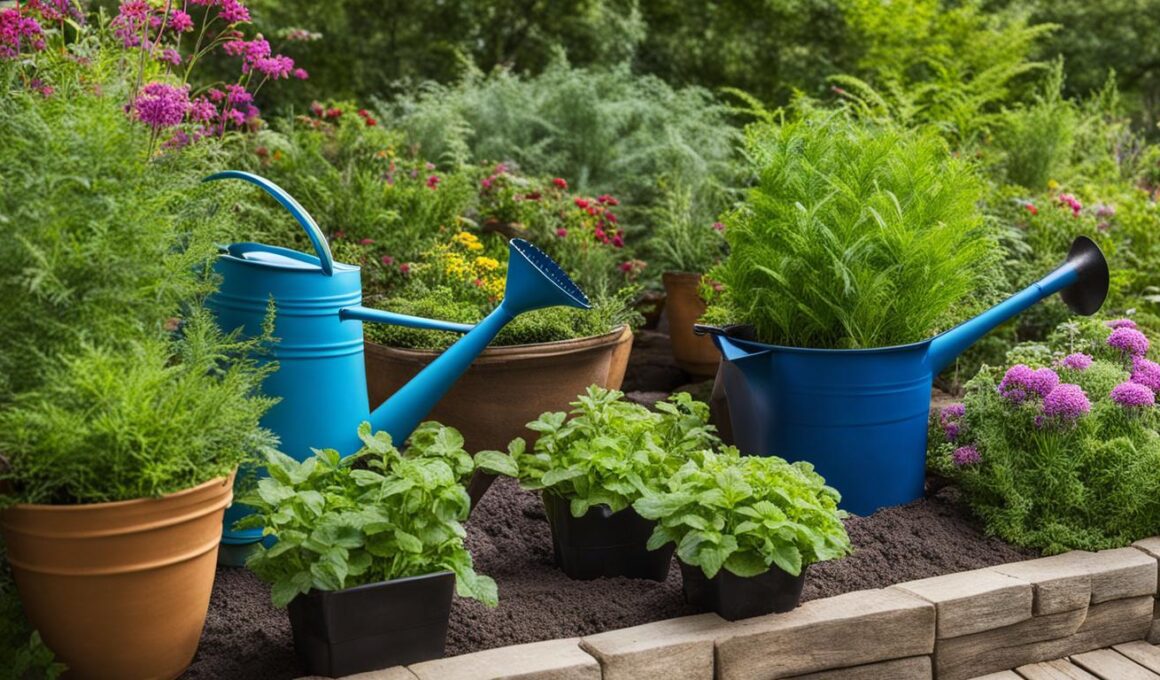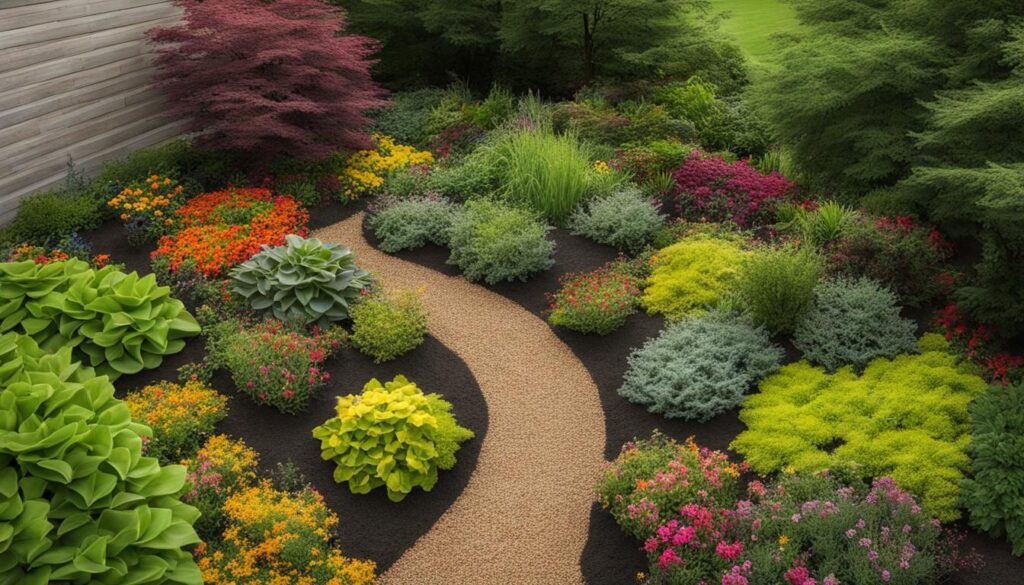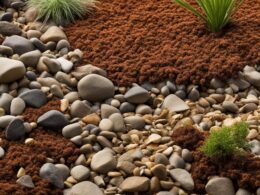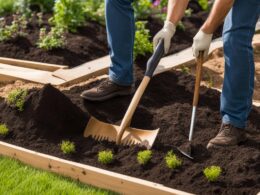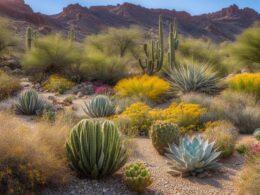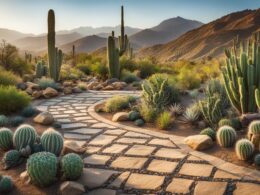Eco-friendly gardening and landscaping practices can improve the sustainability of your yard and benefit the environment. By implementing eco-friendly practices, you can promote healthy plant life, increase the value of your home, and reduce your utility costs. Here are some eco-friendly xeriscape practices that homeowners can start implementing today.
Key Takeaways:
- Implementing eco-friendly practices in gardening and landscaping can boost the local ecosystem.
- Eco-friendly practices can increase the value of your home and reduce utility costs.
- Consider xeriscaping, rainwater harvesting, using mulch, and planting native plants for a more sustainable yard.
- Xeriscaping eliminates the need for irrigation and conserves water.
- Rainwater harvesting allows you to collect and reuse rainwater, reducing water bills.
Xeriscaping
Xeriscaping is a landscaping method that aims to eliminate the need for irrigation completely. It is particularly useful in arid climates where water is scarce and drought conditions are common. By implementing xeriscaping, homeowners can conserve water by using natural water sources, such as rainfall, more efficiently.
This may involve replacing grass with rocks, soil, and drought-resistant native plants, or creating a water pathway in less dry climates. Xeriscaping not only helps prevent excess water usage but also creates a low-maintenance lawn.
With xeriscaping, you can reduce your environmental impact and conserve water while maintaining a beautiful outdoor space. By eliminating the need for irrigation, you can save both time and money on watering your lawn. Furthermore, the use of drought-resistant native plants in xeriscaping promotes biodiversity and supports the local ecosystem.
Benefits of Xeriscaping:
- Eliminates the need for irrigation
- Conserves water in arid climates
- Reduces water bills
- Creates a low-maintenance lawn
- Promotes biodiversity and supports the local ecosystem
Rainwater Harvesting
Rainwater harvesting is a sustainable practice that allows homeowners to collect and reuse rainwater for various purposes. By capturing rainwater, you can conserve water, reduce your water bill, and lessen the strain on local water supplies. One of the simplest ways to start rainwater harvesting is by using containers to collect rainwater from downspouts or rooftops. These containers can range from small rain barrels to larger cisterns, depending on your needs and available space.
Installing a rainwater harvesting system can provide even greater benefits. These systems are designed to capture and store rainwater on a larger scale, making it readily available for use in irrigation, washing vehicles, and other non-potable water needs. A rainwater harvesting system can include components such as gutters, downspouts, filters, and pumps to ensure proper collection, filtration, and distribution of rainwater.
By incorporating rainwater harvesting into your eco-friendly practices, you can contribute to water conservation efforts and reduce your environmental impact. Additionally, utilizing rainwater for outdoor water needs can help alleviate the demand for treated water, which is especially important during periods of drought or water scarcity.
Use Mulch
When it comes to creating an eco-friendly yard, one simple yet effective practice is using mulch. Mulch is a versatile material that offers a wide range of benefits for your plants and the environment. By spreading a layer of mulch over your soil, you can conserve moisture, regulate soil temperature, protect your plants, and prevent weed growth.
Mulch acts as a natural barrier that helps to retain moisture in the soil, reducing the need for frequent watering. This not only conserves water but also helps your plants thrive in dry conditions. Additionally, mulch helps to regulate soil temperature, keeping it cooler during hot summer months and warmer during cold winter months.
Another advantage of using mulch is its ability to protect your plants from various threats. It acts as a physical barrier, preventing weed seeds from germinating and competing with your plants for nutrients and water. Mulch also acts as a cushion, protecting your plants’ roots from extreme temperatures and minimizing soil erosion caused by heavy rain.
Overall, using mulch in your yard is a simple and effective way to promote a healthier and more sustainable environment. By conserving moisture, regulating soil temperature, protecting your plants, and preventing weed growth, mulch can help you create a beautiful and thriving garden while minimizing your environmental impact.
Benefits of Using Mulch:
- Conserves moisture in the soil, reducing the need for frequent watering
- Regulates soil temperature, keeping it cooler in summer and warmer in winter
- Protects plants from weed growth by acting as a barrier
- Minimizes soil erosion caused by heavy rain
Use Native Plants
Incorporating native plants into your yard is not only aesthetically pleasing but also environmentally beneficial. Native plants are species that naturally occur in your region, making them well adapted to the local climate and soil conditions. By choosing native plants for your landscaping, you can conserve water, promote a healthy local ecosystem, reduce lawn water usage, and decrease emissions.
Conserve Water
Native plants are naturally adapted to the rainfall patterns in your area, making them more resilient and water-efficient. They have deeper root systems that can access water deep within the soil, reducing the need for excessive watering. By using native plants in your yard, you can conserve water and reduce your overall water consumption.
Promote Local Ecosystem
Native plants provide essential habitat and food sources for local wildlife, including birds, butterflies, bees, and other pollinators. By planting native flowers, shrubs, and trees, you can create a thriving ecosystem in your yard, supporting biodiversity and contributing to the health of the local ecosystem.
Reduce Lawn Water Usage and Decrease Emissions
Lawns are notoriously thirsty, requiring significant amounts of water for maintenance. By replacing some or all of your grassy areas with native plants, you can significantly reduce lawn water usage. This not only conserves water but also decreases the emissions associated with lawnmower use, fertilizer application, and pesticide treatments.
Native plants offer numerous benefits for both homeowners and the environment. By using native plants in your landscaping, you can conserve water, promote a healthy local ecosystem, reduce lawn water usage, and decrease emissions. Consider incorporating native plants into your yard to create a beautiful, sustainable outdoor space.
What are the most effective eco-friendly xeriscaping practices for busy homeowners?
Busy homeowners can adopt low maintenance xeriscaping practices to create an eco-friendly landscape. By selecting native plants that require less water and mulching the soil, water usage can be minimized. Additionally, incorporating efficient irrigation systems, such as drip irrigation, and using permeable materials for walkways can further reduce water waste. With low maintenance xeriscaping, busy homeowners can enjoy a beautiful, sustainable yard without compromising their limited time.
Conclusion
Implementing eco-friendly practices in your landscaping can have a significant impact on the environment while creating a sustainable and beautiful yard. By conserving water, reducing the use of harsh chemicals, and incorporating sustainable techniques, you can contribute to a more eco-friendly future.
One of the key benefits of sustainable landscaping is the conservation of water. By adopting xeriscaping methods, such as using drought-resistant native plants and eliminating the need for irrigation, you can significantly reduce water consumption in your yard. This not only helps the environment but also reduces your water bill.
Another way to reduce environmental impact is through rainwater harvesting. By collecting rainwater and using it for non-potable purposes like watering plants and washing vehicles, you not only conserve water from traditional sources but also decrease the strain on the local water supply.
Additionally, using mulch and planting native plants can further enhance the sustainability of your yard. Mulch helps conserve moisture, regulate soil temperature, and prevent weed growth, while native plants are adapted to the local climate and require less maintenance and water. These practices not only reduce water usage but also promote a healthier local ecosystem and reduce emissions from lawn maintenance.
By incorporating these eco-friendly practices into your yard, you can create a space that is both aesthetically pleasing and environmentally responsible. Start making a positive impact today by embracing sustainable landscaping and contributing to a more eco-friendly future.





